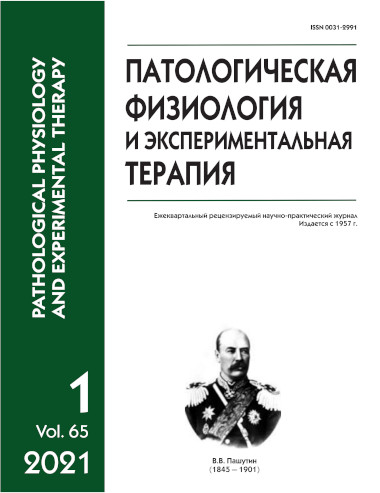Dynamics of chemiluminescence in the small intestine during anesthetic preconditioning in hemorrhagic hypotension
Abstract
Introduction. The major pathogenetic factor of massive blood loss is hypoxia, which triggers activation of free-radical oxidation (FRO) processes in organs and tissues and the systemic inflammatory response. A universal factor of multiple organ dysfunction in blood loss is altered intestinal wall permeability with translocation of microflora and toxins into the systemic circulation during reperfusion. Recently, much of the attention has been focused on effects of anesthetic preconditioning, including during operations associated with hemorrhagic hypotension (HH). The aim of this study was to evaluate in experiment the dynamics of small intestinal FRO in HH during the use of the anesthetic sevoflurane, which has an effect of anesthetic preconditioning. Methods. Experiments were performed on 105 white male rats divided into two groups; groups 1 and 2 were exposed to HH with ether or sevoflurane as the anesthetic, respectively. Two groups of intact animals treated with ether or sevoflurane were used as the controls. Five animals died during the experiment. To evaluate FRO processes, samples of the duodenum, jejunum, and ileum were taken at 15 min, 30 min, 1 h, and 2 h of HH. The chemiluminescence (CL) study of small intestine homogenates was performed according to the Farukhutdinov method on a Fluorate ABLF-2T chemiluninometer. The following FRO indexes were recorded: spontaneous luminosity (SL), flash (F), and light sum (L∑). Significance of differences was determined with the Mann-Whitney test. Results. In the sevoflurane group 2 compared to the ether group after 15 min of HH, SL was increased in the jejunum by 33%; F was decreased in the duodenum by 50%, in the jejunum by 24%, and in the ileum by 36%; L∑ was decreased in the duodenum by 36%, in the jejunum by 45%, and in the ileum by 52%. At 30 min, SL in the jejunum was increased by 80%. In the HH+sevoflurane group, F was decreased in the duodenum by 38%, in the jejunum by 22%, and in the ileum by 27%; L∑ in the duodenum was decreased by 44%, in the jejunum by 45%, and in the ileum by 67%. After 1 h of HH+sevofluran, SL was increased in the jejunum twofold, in the duodenum by 38% and in the ileum by 15%; F was decreased in the duodenum by 67% and in the jejunum by 43%; L∑ in the duodenum was decreased by 62%, in the jejunum by 60%, and in the ileum by 70% compared to the ether group. After 2 h of HH+sevofluran, SL was increased in the jejunum and ileum by 80% and 67%, respectively, compared to the ether group. In this process, L∑ in the duodenum was decreased by 24% and in the jejunum by 15%. Conclusion. The HH+diethyl ether exposure was associated with activation of FRO processes in the small intestine. The sevoflurane preconditioning provided a significant restriction of oxidative stress in the rat small intestine due to activation of the antioxidant system in the duodenum, jejunum, and ileum at 1 h, 15 min, and 30 min of HH, respectively.






